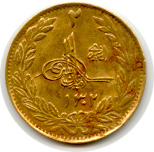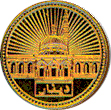 THE GOLD DINAR RESEARCH GROUP
THE GOLD DINAR RESEARCH GROUP 
|
|
|
|
Universiti
Sains Malaysia, Penang
|
About Us | Members | Activities | Articles | Photo Gallery | The Dinar | Zakat | Mahr | Dinar Trade Network| Bookshop | Links | Announcements | Contact Uss
|
|
|
Back
to Articles in Media
|
|
Stability factor in dinarís intrinsic value Shaikh Mohd Saifuddeen Mohd Salleh THE NEW STRAITS TIMES Ikim View (09/11/2002)
|
|||||
|
THE gold dinar has become a topic of interest to many people, especially those in the financial sector. Ever since Prime Minister Datuk Seri Dr Mahathir Mohamad suggested its use for trade among Muslim countries, several seminars have been organised to discuss it. The international seminar organised by the Institute of Islamic Understanding Malaysia (Ikim) a couple of weeks ago has put the idea of establishing a mechanism for using the dinar for bilateral and multilateral trade into high gear. The participants, including bankers and traders from across the Muslim world, welcomed the idea. One of them, representing the Central Bank of Iran, even suggested the establishment of a secretariat, based in Malaysia, to oversee the implementation of the idea. The Prime Minister, during the dialogue session, agreed to this suggestion. Some may view the idea of implementing the dinar for trade with cynicism, looking at the idea as being backward and retrogressive. Gold currency was used for hundreds and thousands of years by past civilisations. So by using the dinar in trade, are we turning the hands of the clock backwards? The answer, as explained by the Prime Minister, arises from the need by countries to use a stable "currency" with intrinsic value that will not fluctuate violently and is not open to speculation. That answer lies with the dinar, which meets all these criteria. As such, the dinar is still relevant, and as the Prime Minister said, a practical way to solve economic and financial woes that beset the world today. The primary motive is to safeguard the country from the rapid fluctuation of the currency exchange rate mechanism. Malaysia learnt a bitter but valuable lesson from the 1997 financial crisis, that currency speculators can at any time attack a country's currency. The nature of currency, which has no intrinsic value, has been identified as the major loophole used by speculators to devalue currencies. Minimising the attacks of currency speculators means dependence on fiat money must be replaced with a form of "currency" that has intrinsic value, making it more stable and reliable. In the past, precious metals such as gold and silver were used. During the peak of the Islamic civilisation, the dinar (gold) and dirham (silver) were used as the main currencies. It must be understood, however, that gold is not entirely free from speculation. Nonetheless, history has proven that the movement of the price of gold is more stable than fluctuations in the value of fiat money. At one point, the ringgit fell by 43 per cent to the US dollar. This is a good illustration of how fluctuations in fiat money can affect trade. Even though the low ringgit was attractive for the export market, the fact remains that the country's import bill climbed substantially. This had an indelible impact on Malaysia's economic development. Another reason for the use of the dinar is the need to increase trade among countries in the Muslim world. Trade among Muslim countries amounts to 12 per cent as compared to trade with non-Muslim countries that stands at 88 per cent. Indeed, it has been argued that for Muslim countries to prosper and develop, intra-trade must be substantially increased, true to the concept of global Muslim brotherhood. The dinar may just hold the answer to this. For most of the international trade conducted today, either bilateral or multilateral, whether among Muslim countries or between Muslim countries and non-Muslim countries, the currencies used are usually the US dollar, the euro or the yen. Therefore, the use of the dinar in bilateral and multilateral trade would symbolise global unity among Muslim countries, which have so often for so long been viewed as being at loggerheads with one another. It has been suggested that to get the dinar mechanism in motion, we must begin with bilateral trade between two trading Muslim countries. Malaysia is working hard to find partners to realise this venture. Careful planning is needed to ensure that when the mechanism is in place, there will be a minimum of problems. As such, to ensure that the mechanism receives support, the country's authorities are giving explanations to other countries so that the concept and reasons behind the dinar are understood. The Ikim seminar even identified several problems that may arise. These problems were deliberated upon and presented to the Prime Minister. Dr Mahathir assured the participants that the problems would be looked into and that care would be taken during implementation to avoid confusion and misunderstanding, in particular among the non-Muslim countries. This brings us to the question of whether the dinar will be accepted by non-Muslims. If we look back to nearly two decades ago, a similar question was posed when the country embarked on the establishment of Islamic financial services and products, which included Islamic banking and takaful (Islamic insurance). The question has been answered. We find that today, Islamic financial services and products are well-received by Muslims and non-Muslims. Statistics show that nonMuslims make up the majority of customers using Syariah-based financing. It must be understood that non-Muslims use services and products that bring about a greater benefit. They do not look at these services and products from a religious perspective. Whichever service or product brings them greater benefit economically and financially will be used. It is no secret that Syariah-based financing is the best means of financing in the long run, and so is popular with non-Muslims. The same argument could be used for the implementation of the dinar scheme. In the long run, it is expected to bring greater benefits to countries using a stable "currency". If this point could be impressed upon other trading countries, the lingering doubts could be answered. The challenge now lies in convincing others of the benefits of using the dinar. Perhaps the hardest question to answer is how superpowers will react to the dinar. Some believe that it will pose a threat to the US dollar. Looking at the international political scenario, it seems as if the United States will certainly react to any idea that may pose threats to its importance. In reality, Malaysia is a sovereign country free to use whatever means is deemed best to develop the nation. Even though most trade today is in the US dollar, this does not mean other currencies cannot be used. If, for instance, the euro or the yen are found to be more advantageous, trading countries may use them. Therefore, Malaysia and other Muslim countries need not feel obliged to use only one currency in trading. As such, the dinar should not be seen as a competitor or even a threat to the US dollar. It should be regarded as another currency being used for bilateral and multilateral trade, in particular among Muslim countries. Indeed, there are still many issues that must be looked at before implementation. They have to be ironed out to ensure that the establishment of the dinar in bilateral and multilateral trade becomes a reality. As pointed out during the Ikim seminar: "It does not matter how many countries support the idea of gold dinar. We only need two countries to begin with. If these two countries succeed, then others will follow suit." This sums up our hope for the future. The writer is a Fellow at the Centre for Economics, Social Studies and Technology, Institute of Islamic Understanding Malaysia (IKIM) |
|||||
Last Updated: 07/06/03 ©NE2002